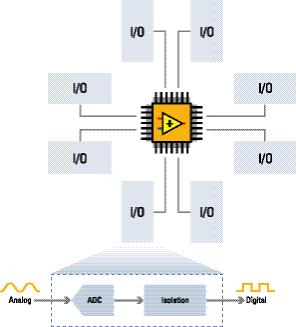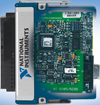
In the midst of a digital era where information is easily accessible through digital sources, the physical world still remains almost exclusively analog.
From wireless broadcasts to wired temperature measurements, analog technologies are as important today as they were 20 years ago. However, digital technologies that complement analog technologies have significantly changed over this same time period. Processing speeds have increased by three orders of magnitude, the Internet has changed the way people obtain information, and PC bus bandwidth has experienced a 500 times improvement. The overall trend shows that digital technology is faster, and engineers are more efficient because of it. How do analog technologies keep up with a faster world where information is quickly crunched and Gigabyte hard drives fill in seconds? By integrating new digital technologies, analog measurements have evolved over the past several years. Six digital technologies that have improved analog measurements include higher-performance analog-to-digital converters (ADCs), digital isolators, reconfigurable field-programmable gate arrays (FPGAs), next-generation PC buses, lower-power MOSFETs, and high-speed digital downconverters.
Analog-to-digital converter trends
When it comes to digitising a real-world signal into its binary representation, it is obvious that ADC quality has a direct effect on measurement accuracy. ADCs have several associated parameters and specifications, but at the highest level, an ADC is characterised by its resolution and sampling speeds. Higher-resolution ADCs can measure smaller signals. Faster sampling speeds can capture more of the original analog signal in the digital representation.

Over the past decade, increased innovation in the electronic component industry has resulted in decreased ADC component costs while simultaneously increasing performance. This trend led to higher-performing devices at prices often less than that of legacy devices. Today for example, high-performance NI M and S Series data acquisition (DAQ) devices feature one or more ADCs, 16-bit or higher resolutions, and 1 MS/s or faster sampling rates at prices less than that of the first PC-based data acquisition devices of the late 1980s, which featured a single 12-bit, 10 kS/s ADC. Sampling speeds of commercially available ADCs also have significantly increased over the decades. For example, the new National Instruments PXI-5105 high-speed digitiser packs in eight 12-bit ADCs sampling at 60 MS/s simultaneously, and the National Instruments PXI-5152 digitises signals as fast as 2 GS/s. By designing around new ADC technologies, NI continually improves analog measurement capabilities with lower-cost, higher-performance devices.
Digital isolation protects investments and increases accuracy
Isolation adds safety to measurement systems by electrically separating different parts of the data acquisition circuitry. Isolation prevents hazardous voltages from damaging the measurement device, other electrical equipment, and you as the human operator. Traditional isolation schemes use analog isolation components based on amplifiers or transformers. Analog isolation technologies are nonlinear; susceptible to drift, and expensive with regard to power consumption, physical space and price. Analog measurement systems often omit isolation due to the drawbacks of analog isolators for faster, more accurate, and less costly systems.
To eliminate these limitations, silicon vendors introduced new isolation components that use digital designs based on transistor-level transformers. Digital isolation provides faster, more accurate, higher-density, and lower-cost solutions, ensuring the safety of measurement systems. In addition to the increased safety provided by devices with digital isolation technologies, isolation removes ground loops, reduces system noise, and rejects common-mode voltages. New NI devices - including isolated M and S Series DAQ devices as well as C Series modules used in NI CompactDAQ and NI CompactRIO - use digital isolation to protect investments and increase measurement accuracy.

'Custom' off-the-shelf hardware with FPGA technologies
It seems oxymoronic to mention custom hardware in the same context as commercial technologies, but it is now possible by using FPGAs in combination with analog designs. Previously, if a commercially available system was incapable of performing particular measurement types, you often had nowhere to turn except to a custom solution. However, by replacing the onboard vendor-defined system timing controller, which controls sampling rates, triggering, and bus transfer, with a reconfigurable FPGA, you now can create custom hardware by redefining the way the hardware operates. With FPGA-based designs, including NI R Series intelligent DAQ devices and CompactRIO, you can create custom sampling, triggering, and onboard processing with 25 ns resolution and 40 MHz loop rates. To aid in productivity, you are not required to learn VHDL or other low-level design languages when using National Instruments' FPGA-based designs. Instead, with the NI LabVIEW FPGA Module, you can design custom hardware without leaving the graphical programming environment.
Improving analog measurements with digital technologies
You use measurements to help pass or fail units under test, repair corrupted signals, and tell you what exists beyond what the eye can see. Today, the measurements you make demand higher speeds and higher accuracy, the enterprise demands increased safety, system requirements demand customisation, and the economy demands lower prices. Through the use of commercial technologies, National Instruments extends the capabilities of measurement hardware by leveraging new ADCs, digital isolation technologies, and reconfigurable FPGAs. It is clear that today and in the future, digital technologies will continue to extend the capabilities of analogue measurement.
For more information contact National Instruments toll-free on +27 (0) 800 203 199, [email protected]

© Technews Publishing (Pty) Ltd | All Rights Reserved